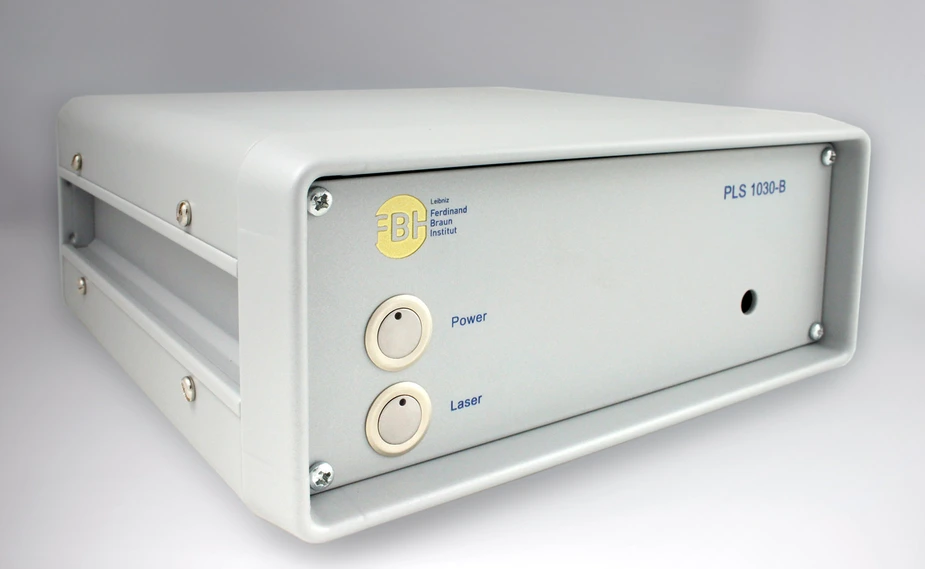Extremely versatile – Tailored diode lasers, from the chip to the system
FBH presents its capability at “Laser World of Photonics” trade show and accompanying “CLEO Europe” conference
The Ferdinand-Braun-Institut (FBH) presents novel developments and advances of its diode lasers and UV light-emitting diodes (LEDs) at the “Laser World of Photonics”. The event is hosted in Munich from June 26 – 29, 2017. FBH offers the full value chain in house: from design through chips to modules, and increasingly develops these devices for use as operational systems. At the booth, FBH showcases, among others, a unique, computer-controlled picosecond light source delivering high-precision pulses in the pico- and nanosecond range, a 6 kW fiber-coupled pump module for solid-state laser systems, and a demonstrator module equipped with UV-C LEDs for water disinfection purposes. The LEDs utilized have been developed within the “Advanced UV for Life” consortium that is managed by the FBH and also exhibits at the stand.
Flexible all-in-one pulse light source PLS 1030
With its PLS series, FBH offers unique laser sources that deliver high-precision pulses in the pico- and nanosecond range with nanojoule energies. Pulse energy, width, and spacing as well as repetition frequencies can be flexibly adjusted. The laser system offers freely selectable repetition rates from the hertz to the megahertz range and peak pulse powers of up to 50 watt. It uses tailored diode lasers for impulse generation combined with optimized RF components as electronic drivers – both are core competencies of the institute.
The computer-controlled all-in-one system can be switched into different pulse modes and thus be integrated into various laser systems at low effort. The system is equipped with 1030 nm diode lasers, but can be easily adapted to other wavelengths. It is therefore suited for applications like material processing, bio-medical examinations, and mobile LIDAR systems. PLS 1030 was constructed jointly by laser and RF circuit experts with engineers from the in-house Prototype Engineering Lab, an FBH team that develops industry-ready and user-friendly prototypes. This way, companies get direct access to the latest state-of-art research results.
Efficient diode lasers for applications with kilowatt-class output powers
The institute develops high-brilliance diode lasers in a great variety of designs in the wavelength range from 630 nm to 1180 nm. All FBH activities aim at steadily increasing efficiency, reliability, and output power of its diode lasers and bars. In recent work, laser bars with 6 mm long resonator and 10 mm aperture have reached output powers of 1 kW, whilst maintaining an excellent conversion efficiency of 63%. Detailed results for these bars are presented at “CLEO Europe”.
Bars with long cavities of this kind provide ultra-low thermal and electrical resistances. They are therefore anticipated to be highly beneficial for kW-level CW operation and thus particularly attractive for industrial and scientific high-power applications. For example, such diode laser bars are used as pump sources for solid-state and fiber lasers or employed directly in material processing.
Innovations from the FBH regarding chip design and technology along with mounting and module design have enabled, at the same time, advances in pumping of solid-state systems. To this end, novel chips with a very broad aperture of 1.2 mm were integrated into innovative side-cooled stacks that are particularly suitable for pulsed operation with a larger duty cycle of 20%. The high-intensity output of the single emitters in the stacks is optically combined into a beam and then coupled with low losses into a fiber. In this way, a pump laser system is available for the first time that simultaneously offers high power, good efficiency, and a long duty cycle. Novel high energy class solid-state lasers can therefore be efficiently pumped with these systems. FBH presents an exemplary pump laser module with 6 kW peak power and an electro-optical efficiency of 50% at the booth.
High-brilliance tapered lasers with further increased output power
Tapered lasers deliver high optical output powers in a narrow spectral line with equally excellent beam quality. The FBH recently succeeded in further enhancing their output power in the spectral range between 980 nm to 1120 nm. The newly developed 1030 nm tapered diode lasers yield up to 10.3 W diffraction-limited output power, much increased to the previous record of 8 W. This corresponds to 76% of the emitted light output. This improvement was due to further optimization of the lateral spatial mode filtering and the internal wavelengthselective gratings. The latter ensure laser emission within 22 pm spectral width over the full operating range. Hence these diode lasers are also suitable for challenging applications like non-linear frequency conversion.
Visit us at “Laser World of Photonics“ in hall B2, booth 350. An overview of FBH contributions at CLEO Europe is provided here: bit.ly/2sD92GC.
Contact:
Petra Immerz, M.A.
Communications & Public Relations
Ferdinand-Braun-Institut Leibniz-Institut für Höchstfrequenztechnik
Gustav-Kirchhoff-Straße 4
12489 Berlin, Germany
Tel. 030 6392-2626
Fax 030 6392-2602
Email petra.immerz(at)fbh-berlin.de
Web www.fbh-berlin.de
Background information – the FBH
The Ferdinand-Braun-Institut, Leibniz-Institut fuer Hoechstfrequenztechnik (FBH) researches electronic and optical components, modules and systems based on compound semiconductors. These devices are key enablers that address the needs of today’s society in fields like communications, energy, health, and mobility. Specifically, FBH develops light sources from the visible to the ultra-violet spectral range: high-power diode lasers with excellent beam quality, UV light sources and hybrid laser systems. Applications range from medical technology, high-precision metrology, and sensors to optical communications in space. In the field of microwaves, FBH develops high-efficiency multi-functional power amplifiers, and millimeter wave frontends targeting energy-efficient mobile communications as well as car safety systems. The FBH has a strong international reputation and ensures rapid transfer of technology by working closely with partners in industry and research.
The institute has a staff of 290 employees and a budget of 28 million Euros. It is part of the Forschungsverbund Berlin e.V., a member of the Leibniz Association and plays an active role in various networks.
www.fbh-berlin.com
